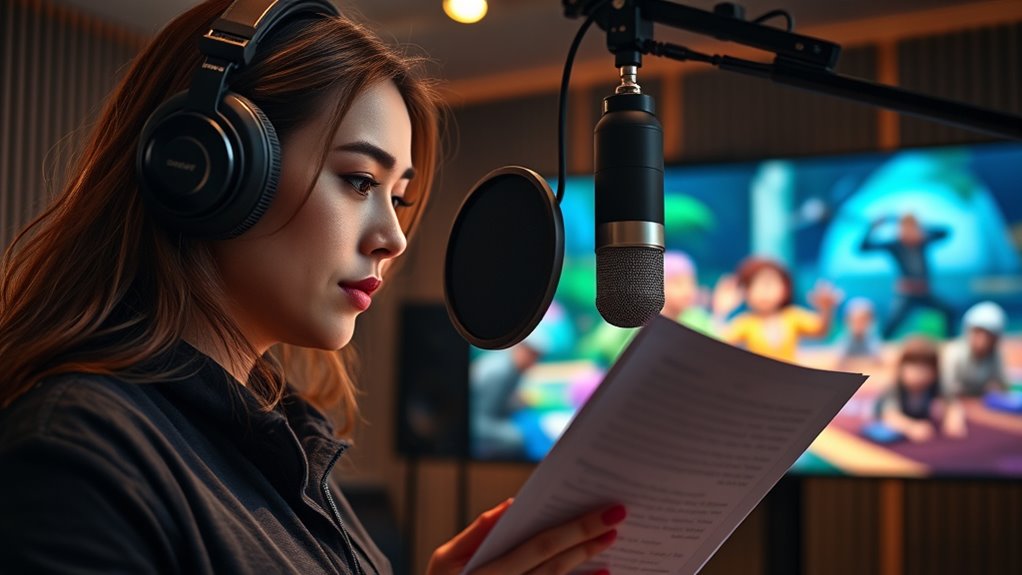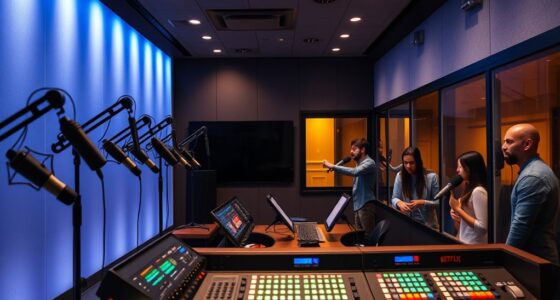When you explore video game dubbing, you realize it’s about more than just translating words. It involves recreating authentic performances that match the original characters’ personalities and emotions, all while fitting different languages and cultures. You’ll discover how voice actors, translators, and developers work closely together to overcome technical and artistic challenges—like timing and synchronization—to create seamless and immersive experiences. Keep going, and you’ll learn how these efforts shape the game worlds you love.
Key Takeaways
- Effective translation maintains character personality and emotional tone across languages.
- Synchronizing voice lines with animations and lip movements is crucial for immersion.
- Cultural adaptation ensures dialogues resonate and avoid insensitivity or awkwardness in different markets.
- Close collaboration between translators, voice actors, and developers optimizes localization quality.
- Technical constraints and budget limitations influence the scope and quality of dubbing efforts.

Have you ever wondered how the voices behind your favorite video game characters come to life? It’s a fascinating process that combines talent, technology, and a deep understanding of storytelling. Voice acting is at the heart of creating memorable characters, giving them personality and emotional depth that resonate with players. But behind the scenes, there’s a complex web of challenges, especially when it comes to localization. When a game is developed for international audiences, the original voice recordings often need to be adapted to fit different languages and cultural contexts. This is where localization challenges come into play, and they can make or break the player’s experience.
In voice acting for video games, you’re not just recording lines—you’re embodying a character, capturing their nuances, emotions, and intentions. A skilled voice actor brings authenticity and life to the role, making the game world more immersive. However, when adapting a game for different markets, the process becomes more complicated. Localization challenges involve more than translating words; they require adjusting dialogues to fit cultural norms, humor, idioms, and voice tone. Sometimes, a phrase that sounds natural in one language might seem awkward or insensitive in another, so voice actors and localization teams work closely to guarantee the dialogue feels authentic and natural in each language.
Timing and synchronization are also critical. The original voice recordings are often carefully timed to match character animations and on-screen lip movements. When translating scripts, you need to preserve this synchronization, which can be tricky, especially if the translated text is longer or shorter than the original. This may require re-voicing lines or adjusting animations, adding another layer of complexity. Additionally, technical constraints such as recording equipment, studio availability, and budget limitations can influence how voice acting and localization are executed. Understanding Gold IRA options can help developers and publishers allocate resources effectively for such production needs.
Despite these challenges, the goal remains the same: to deliver a seamless and engaging experience for players worldwide. Effective voice acting and thoughtful localization ensure that characters feel genuine, regardless of the language. You might never see the hours of work that go into perfecting a single line, but when a game’s voice sounds natural and compelling across different languages, you can be sure that a lot of effort went into overcoming the hurdles of voice acting and localization challenges. Ultimately, it’s this dedication that helps create interactive narratives that captivate players and bring game worlds to life across the globe.
Frequently Asked Questions
How Do Voice Actors Adapt Their Performances for Different Game Genres?
You adapt your performances by focusing on character consistency, ensuring your voice matches each character’s personality across scenes. You also use emotional range to convey different moods convincingly, whether it’s tension, joy, or fear. By adjusting your tone, pitch, and pacing, you make the experience immersive for players. This flexibility helps you bring diverse game genres to life, making each character feel authentic and engaging throughout the story.
What Challenges Are Unique to Dubbing Multiplayer Versus Single-Player Games?
Coincidences often highlight how dubbing multiplayer games challenges you to match voice performance with dynamic multiplayer interactions. You must adapt to unpredictable player dynamics, making your voice responsive and versatile. Unlike single-player, where you focus on narrative consistency, multiplayer dubbing demands real-time reactions and synchronization with player actions. This unique challenge requires heightened flexibility, ensuring your voice enhances the immersive experience amid fluctuating multiplayer scenarios.
How Is Cultural Localization Handled in Game Voice-Over Translations?
You handle cultural localization by carefully adapting voice-overs to reflect cultural nuances and language idioms, ensuring the game feels authentic to players. You research regional differences, idiomatic expressions, and local customs, then work with voice actors to incorporate these elements naturally. This process helps players connect with the story and characters, making the experience more immersive and respectful of diverse cultures.
What Technological Advancements Are Shaping the Future of Game Dubbing?
Imagine a future where your game characters breathe with life through AI synthesis and motion capture, transforming voice dubbing. These technological advances let you experience authentic emotions and seamless lip-syncing, making interactions more immersive. AI synthesis rapidly creates realistic voices, while motion capture ensures gestures match dialogue perfectly. Together, they revolutionize game dubbing, allowing developers to craft more engaging worlds where every voice and movement feels genuine and enthralling.
How Do Developers Ensure Lip-Sync Accuracy Across Diverse Languages?
You guarantee lip-sync accuracy across languages by using advanced techniques like motion capture and phoneme mapping. Motion capture records actors’ facial movements, providing realistic animations, while phoneme mapping aligns speech sounds with mouth movements in different languages. These methods help you synchronize dialogue precisely, maintaining character expressiveness and immersion, regardless of language differences. This technology allows developers to deliver seamless, authentic dubbing experiences for diverse global audiences.
Conclusion
Dubbing in video games isn’t just about translation; it’s about creating an immersive experience. Did you know that over 70% of gamers prefer playing games in their native language? This shows how essential accurate, culturally sensitive dubbing is for engagement. When done right, it deepens your connection to the story and characters. So, next time you play, appreciate the skill behind the voices that bring your favorite interactive worlds to life.









